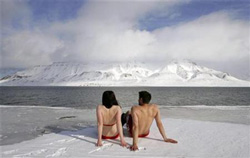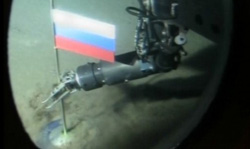No scramble for the Arctic - yet
on
No scramble for the Arctic - yet
If the ice in the Arctic melts, a new ocean five times the size of the Mediterranean will be formed, potentially providing access to huge fossil fuel resources. But oil companies are not rushing to the North Pole yet. It will be decades before there can be any question of tapping the region’s oil and gas – if it happens at all.
 |
| The warming up of the arctic offers new possibilities |
| Highlights: |
| -With the ice in the Arctic apparently melting, potentially huge oil and gas resources might become available for exploitation. -Still, the oil industry is not rushing to the Arctic yet. There are still too many uncertainties with regard to ownership issues – and costs. -Hence, new shipping routes will become a reality sooner than new oil and gas production. -Yet these might lead to activities by oil companies, a prospect which the environmental movement finds horrifying. |
Still, this does not mean that the Arctic fields will become easily accessible. To begin with, the problem of who owns these resources has to be resolved. Then there are the harsh environmental conditions and high exploitation costs which might make oil and gas production in the region simply unprofitable.
It is exactly 100 years since the American Robert Peary reached the North Pole, presumably the first man to do so, on 6 April 1909. Until recently, the High North, as the northern polar region is called, had received little public attention. It was seen as a prospective battleground in the Cold War, when the US and the Soviet Union stationed bombers, rockets and radar units in the region. Economic interest was first aroused when the polar ice was seen to be melting and gas was discovered in the Barents Sea. However, Arild Moe, Deputy Director of the Norwegian Fridtjof Nansen Institute (FNI), says the level of economic interest should not be exaggerated. ‘It is a hype that has come from the media and politicians rather than from the oil industry which has maintained a much more conservative position.’
Karsten Klepsvik, polar affairs adviser for the Oslo Ministry of Foreign Affairs and, in his role as head of the Norwegian delegation, president of the Arctic Council until April 2009, shares this view. ‘The oil companies are observing developments but not exerting any pressure or attempting to hurry things along.’
Law of the Sea
Still, the world took notice when Russia in 2007 planted a Russian flag on the sea floor beneath the North Pole at a depth of 4,200 metres apparently to stake a territorial claim to the riches that might lie underneath the seabed. This gave the impression that the Arctic was in a state of lawlessness which could become dangerous in the future. To clear up matters, Denmark’s foreign minister, Per Stig Möller, in May 2008 invited his counterparts from Norway, Canada, the US, and Russia, to the small West Greenland township of Ilusisat to talk things over. After this meeting he was extremely satisfied to be able to report that everyone had quickly come to the agreement that in the Arctic waters the UN Law of the Sea applied. The Danish foreign minister, as representative of the interests of Greenland which, although it is largely independent, still officially belongs to the kingdom of Denmark, said: ‘The five countries have declared that they will observe the rule of the Law of the Sea. We hope that with this we have got rid of the myth of an uncontrolled scramble for the North Pole once and for all.’ Arild Moe also welcomes this declaration, ‘through which these countries have determined that the situation in this region is not one of lawlessness.’ He says that the countries will divide the natural resources according to the stipulations in the UN convention.
 |
| In 2007, Russia planted a Russian flag on the sea floor beneath the North Pole at a depth of 4,200 metres |
There is still one remaining area of uncertainty: The US has not yet ratified the Law of the Sea, which came into effect in 1994, as a result of ideological opposition in the US Senate. However, the FNI Director is optimistic. ‘They will probably soon come to accept that a failure to ratify is counterproductive for the US as it shuts Washington out of the discussion.’
One important clause of the convention is that it limits the economic zone of a country to 200 nautical miles. There is one important exception: where the continental shelf exceeds this limit, the zone can be increased. This paves the way for conflict between Denmark and Russia.
There is a 1,800 km long mountain range, the Lomonosov Ridge, running right across the Arctic Ocean. Russia claims that it is an extension of its continental shelf and therefore claims an additional 1.2 million square kilometres of seafloor (an area the size of South Africa), including the territory underneath. (Hence the PR-stunt with the Russian flag.) A few years ago, Moscow lodged a claim for this with the relevant authority, the International Sea Bed Authority in Kingston, Jamaica. However, it was ruled that the evidence provided was insufficient to prove Moscow’s case. A new claim is being prepared. Denmark has similar intentions. If the Authority decides that both countries have at least partially valid claims, which is thought likely by Arctic experts, they will have to come to a mutual agreement. The Authority, however, will not adopt a mediation role. Arild Moe somewhat reluctantly poses the question: ‘How will Russia react politically if its latest claim is rejected?’
Controversial
Evidence of growing interest in the Arctic is seen in the waiting list for membership of the Arctic Council. Following the definition of the polar region as the area around the North Pole north of the Arctic Circle, the members of the Council, founded in 1996, include the US, Canada, Denmark/Greenland, Russia, and Norway, and also Iceland, Sweden and Finland. These are the only countries with voting rights. Six further countries have observer status: the UK, France, Spain, Germany, the Netherlands, and Poland. There are also five applications for membership pending, from China, Japan, South Korea, Italy and the EU. Until a final decision is made, which must be unanimous, these countries have what is called ad-hoc status.
The EU’s quest for membership is particularly controversial. According to one member of the Arctic Council, the content of the EU’s communication paper, “The European Union and the Arctic Region”, has raised a number of questions, especially in the US, Canada, and Russia. Based on the fact that three of its members (Sweden, Finland and Denmark, although interestingly Greenland has withdrawn from the EU) are members of the Council, and that Iceland and Norway belong to the European Economic Area, Brussels sees itself as being ‘inextricably linked to the Arctic region’ Klepsvik emphasises that ‘Norway wants the EU to be a member. It has a legitimate right. EU countries own 40% of the world’s shipping fleet and they strongly support Arctic research.’
Whichever way the continental shelf issue will be resolved, most of the Arctic Ocean is already in the economic zones of the neighbouring countries. Only a relatively small portion is still free. And where are the tempting oil and gas reserves? Almost all data on potential natural resources come from the US Geological Service. A year ago it hit the news with its assessment that approximately 25% of the world’s undiscovered oil and gas reserves were beneath Arctic waters. Later it reduced this figure to 20% when new tests failed to confirm anticipated reserves off the west coast of Greenland. Less is known of the Russian side. The Swedish North Pole expert, Martin Jakobsson, praises the US for releasing its data, while Russia has only made some of its material available. The evidence on which Russian documentation is based is classified as a military secret.
The oil companies also tend to be secretive when it comes to their findings. One thing is certain, though – it will be decades before serious consideration can be given to tapping into the oil and gas reserves in the Arctic Ocean, if it happens at all. Most experts agree that there are far too many uncertainties to consider a serious search for oil and gas. The first obstacle is the climate. It is extremely harsh; and should the ice disappear this might cause changes to both wind and water currents and possibly lead to more fog. There are also the big technical challenges of drilling in very deep water. And the problem of transportation would need to be resolved. The distances in the region are enormous.
Thinnest ice sheet
New shipping routes are more likely to become a reality sooner than gas and oil production. In 2007, the Arctic experienced its thinnest ice sheet ever. One must go back 125,000 years to find a similar development. In the Arctic Climate Impact Assessment (ACIA) of 2004, it was reported that in approximately 100 years the Arctic might be free of ice in the summer months. The latest forecast is that this could happen in less than 25 years. Klepsvik notes that this year the situation is better, but the trend is nevertheless clear.’
From 1878 to 1880, the Finnish-Swedish explorer, Adolf Erik Nordenskiöld, was the first to succeed in conquering the Northeast Passage. Since then it, and the Northwest Passage, have been the dream of shipping logisticians. This summer Beluga, a German shipping company, sent two special ships for heavy haulage from South Korea through the Northeast Passage to Siberia. Six further journeys are planned for 2010. But how great is the demand and how economic will it be to run this route? A freighter strengthened for ice would be 30 to 50% more expensive, and a freighter built as an ice-breaker would be three times more expensive. On the other hand, the route from Hamburg to Shanghai would be 30% shorter and a trip from Europe to America through the Northwest Passage could avoid the Panama Canal. A third alternative could be a trip directly over the North Pole.
The experts disagree as to whether or not such an undertaking can be realised. A critical problem would be how ships in distress could be rescued. Morten Mejlaender-Larsen from the risk classification society Det Norske Veritas has concluded after many years of investigation that ‘from our point of view, it is not technology which would prevent a safe and well-planned shipping route through the arctic waters. The greatest uncertainty is what would happen in case of an accident. What would it cost to call a Russian ice-breaker?’ It is highly likely that the Arctic Ocean will only be free of ice for a few summer months, but it is possible that the ice sheet would be so thin during the rest of the year that travel with special ships would still be possible. The deployment of rescue helicopters would not be feasible in large parts of the region due to the large distances involved. The easiest route would be to go directly over the pole as it would go through international waters.
One big question is what conditions would Russia set to allow travel along its coast. At the same time the US and Canada are already in conflict over the Northwest Passage. Canada claims this route as being in its national waters, while the US sees it as being in international waters. Des Upcraft, from the British classification and risk management society Lloyds Register, notes that the Northeast Passage would hardly be suitable for container traffic: ‘To be able to use the Northeast passage, container ships would have to be 4,500 to 5,500 TEU in size. By way of comparison, the largest container ships are currently 13,000 TEU in size.’
Black carbon
Whether there is oil and gas production or a shipping route, one question will remain: How much will they damage the arctic environment? ‘Immensely’, says Frederic Hauge, founder and president of the respected Norwegian environmental organisation Bellona. He fears that ‘if new shipping routes are opened this could lead to an increase in the pressure to search for oil and gas.’
 |
| Christophe the Margerie (Total), Alexey Miller (Gazprom) and Helge Lund (Statoil) shake hands on the development of the first phase of the Shtokman project |
Klepsvik points to the black carbon which was first discovered three years ago. This is a short-lived particulate air pollutant created through burning fossil fuels. When it blows to the north it falls over the Arctic. There, it colours the snow black which results in greater heat absorption and an increase in the rate at which the ice is melting. However, Klepsvik is ‘cautiously optimistic’, as humans have the chance to do something good.
In the end the fate of the Arctic will be decided by politics. Russia has re-instituted the patrol flights which it stopped in the beginning of the nineties. Canada and Norway are modernising and strengthening their naval units. These actions, however, are billed as “normal measures” to protect national and joint interests. Words such as consensus and cooperation are commonly heard, especially when governments and supranational organisations talk about the Arctic. By contrast, environmental organisations talk about the need for the greatest level of vigilance.


Discussion (0 comments)